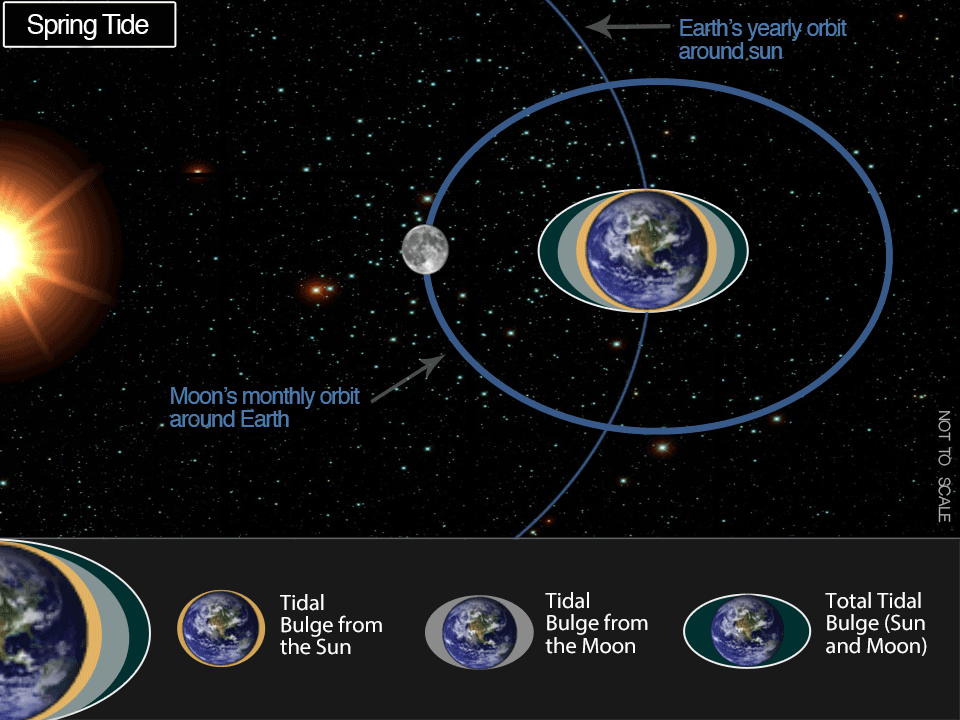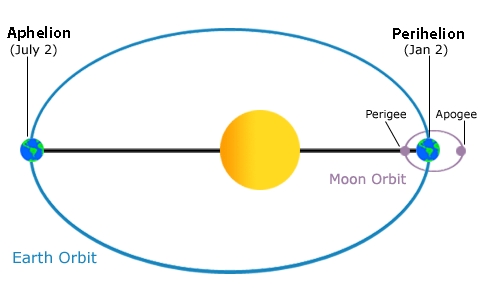Tides and Water Levels
Tidal Variations - The Influence of Position and Distance
The moon is a major influence on the Earth’s tides, but the sun also generates considerable tidal forces. Solar tides are about half as large as lunar tides and are expressed as a variation of lunar tidal patterns, not as a separate set of tides. When the sun, moon, and Earth are in alignment (at the time of the new or full moon), the solar tide has an additive effect on the lunar tide, creating extra-high high tides, and very low, low tides—both commonly called spring tides. One week later, when the sun and moon are at right angles to each other, the solar tide partially cancels out the lunar tide and produces moderate tides known as neap tides. During each lunar month, two sets of spring tides and two sets of neap tides occur (Sumich, J.L., 1996).

Together, the gravitational pull of the moon and the sun affect the Earth’s tides on a monthly basis. When the sun, moon, and Earth are in alignment (at the time of the new or full moon), the solar tide has an additive effect on the lunar tide, creating extra-high high tides, and very low, low tides — both commonly called spring tides. One week later, when the sun and moon are at right angles to each other, the solar tide partially cancels out the lunar tide and produces moderate tides known as neap tides. During each lunar month, two sets of spring and two sets of neap tides occur.
Just as the angles of the sun, moon and Earth affect tidal heights over the course of a lunar month, so do their distances to one another. Because the moon follows an elliptical path around the Earth, the distance between them varies by about 31,000 miles over the course of a month. Once a month, when the moon is closest to the Earth (at perigee), tide-generating forces are higher than usual, producing above-average ranges in the tides. About two weeks later, when the moon is farthest from the Earth (at apogee), the lunar tide-raising force is smaller, and the tidal ranges are less than average. A similar situation occurs between the Earth and the sun. When the Earth is closest to the sun (perihelion), which occurs about January 2 of each calendar year, the tidal ranges are enhanced. When the Earth is furthest from the sun (aphelion), around July 2, the tidal ranges are reduced (Sumich, J.L., 1996; Thurman, H.V., 1994).

The elliptical orbits of the moon around the Earth and the Earth around the sun have a substantial effect on the the Earth’s tides. Once a month, at perigee, when the moon is closest to the Earth, tide-generating forces are higher than usual, producing above average ranges in the tides. About two weeks later, at apogee, when the moon is farthest from the Earth, the lunar tide-raising force is smaller, and the tidal ranges are less than average. When the Earth is closest to the sun (perihelion), around January 2 of the calendar year, tidal ranges are enhanced. At aphelion, when the Earth is furthest from the sun, around July 2, tidal ranges are reduced (Sumich, J.L., 1996; Thurman, H.V., 1994).
Tides and Water Levels
